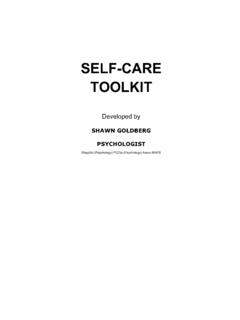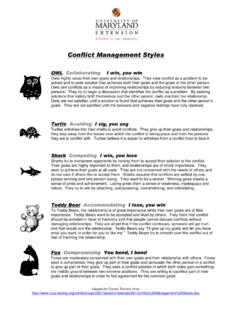Transcription of Financial Stress, Self-Efficacy, and Financial Help ...
1 148 Journal of Financial Counseling and Planning Volume 25, Issue 2, 2014, 148-160. 2014 Association for Financial Counseling and Planning Education . All rights of reproduction in any form reservedFinancial Stress, Self-Efficacy, and Financial Help-Seeking Behavior of College StudentsHanNa Lim1, Stuart J. Heckman2, Jodi C. Letkiewicz3, Catherine P. Montalto4 Financial stress and self-efficacy are examined in relationship to college students Financial help-seeking behavior utilizing Grable and Joo s (1999) framework. A cognitive approach is taken by focusing on the moderating role of Financial self-efficacy on the relationship between Financial stress and Financial help-seeking. Data from the 2010 Ohio Student Financial Wellness Survey are analyzed. Logistic regression results indicate that those who are Black, have had a Financial education course, have larger current student loan debt, experience higher levels of Financial stress, and have high Financial self-efficacy tend to seek help from professionals.
2 A moderating role of Financial self-efficacy is observed, although the effect is relatively weak. Implications for Financial counselors, educators, and practitioners include attention to strategies for reaching populations that underutilize available services, increased effort to reach populations most in need of services, and optimizing opportunities for the inclusion of Financial information as an antecedent to productive service : college students, Financial stress, help-seeking, self-efficacyAccording to the National Center for Education Statistics, the price of undergraduate tuition, room, and board increased 42% at public institutions and 31% at private institutions between the 2000 and 2010 academic years, after adjusting for inflation (NCES, 2012a). To afford the rising cost of education, students turn to borrowing and, as a result, many graduate with debt.
3 Consequently, two-thirds of four-year college students report having completed their degree with some form of debt (NCES, 2012b). Recent national surveys show that college students debt and other related Financial situations are one of the leading causes of stress. Finances were ranked as the second largest stressor among college students, following academics, in the National College Health Assessment (ACHA, 2011). More than one-third of the respondents report that finances are traumatic or very difficult to handle. Additionally, results from the 2012 National Survey of Student Engagement (NSSE, 2012) indicate that finances are a significant concern for the majority of college students and that three in five first-year students worry about paying for school and having enough money for regular expenses.
4 Furthermore, in a national survey of college students and recent college graduates by Inceptia, four of the top five stressors identified by currently enrolled college students were related to personal finances, such as the need to repay loans, the cost of education, borrowing money for college, and the need to find a job after school (Trombitas, 2012). Since Financial stress has been associated with academic failure (Joo, Durband, & Grable, 2008; Ross, Cleland, & Macleod, 2006; Trombitas, 2012; Wharton, 2007), adverse health issues (Nelson, Lust, story , & Ehlinger, 2008; Westefeld et al., 2005), and negative Financial practices (Hayhoe, Leach, Turner, Bruin, & Lawrence, 2000), identifying the factors affecting college students coping behaviors is an important component of the effort to improve college students well-being.
5 Grable and Joo (1999) summarized the coping strategies related to Financial problems that have been documented in the previous literature, which include reducing expenses, increasing income, improving management skills, borrowing money, employing psychological means to reduce or avoid stress, and seeking help. This study focuses on seeking Financial help as a coping strategy for college students dealing with stress from personal purpose of this study is to identify factors related to college students seeking Financial help based on Grable and Joo s (1999) Financial help-seeking behavior framework. In this paper, Financial help refers to professional personal Financial help. Although students may seek Financial help from 1 Retirement Research Center, Samsung life Insurance, #55, Sejong Street, Junggu, Seoul, Korea, 100-716, (82-2) 772-6309, 2 School of Family Studies and Human Services, Kansas State University, 319 Justin Hall, Manhattan, KS 66506, (785) 532-1371, of Administrative Studies, York University, 4700 Keele Street, 204 Atkinson, Toronto, ON M3J 1P3, Canada, (416) 736-2100 ext.
6 33630, of Human Sciences, The Ohio State University, 1787 Neil Avenue, #115F, Columbus, OH 43210, (614) 292-4571, of Financial Counseling and Planning Volume 25, Issue 2, 2014other sources ( , family members or friends), our focus is on seeking help from personal finance professionals. In addition, this study incorporates a cognitive approach into the original framework by positing a moderating role for Financial self-efficacy between Financial stress and seeking Financial help. Acknowledging the increasing interest in the role of psychological factors in Financial behavior ( , Hira, 2010; Lown, 2011), this study furthers our understanding of the psychological influences on college students Financial help-seeking behavior by combining theoretical frameworks from personal finance and ReviewFinancial Help-Seeking BehaviorHelp-seeking behavior has been studied extensively in medical, psychological, and sociological research (Grable & Joo, 1999).
7 However, until Grable and Joo (1999) developed a framework applied to Financial help, there had been very limited research on Financial help-seeking behavior. Grable and Joo viewed help-seeking behavior as a coping strategy related to Financial problems and based their approach on help-seeking behaviors in health care decision-making processes (see Suchman, 1966). The Financial help-seeking process consists of five stages: (1) the exhibition of Financial behaviors, (2) the evaluation of own Financial behaviors, (3) the identification of the causes of Financial behaviors, (4) the decision to seek help, and (5) the choice among help assistance options. Based on Grable and Joo s framework, two streams of research are most prevalent: the decision to seek help (stage 4) and from whom or what type of help to seek (stage 5).
8 Grable and Joo s (1999) empirical analysis examined whether demographic and socioeconomic factors, Financial knowledge, Financial stressors, Financial risk tolerance, and Financial behaviors were determinants of help-seeking behavior among clerical workers. The results from the discriminant analysis showed that individuals who were younger, did not own homes, reported high levels of Financial stressors, or reported poor Financial behaviors were more likely to seek help. Britt et al. (2011) explored factors affecting whether students seek on-campus, peer-based Financial counseling. Data were obtained from students who sought free Financial counseling from an on-campus Financial counseling center (the clinical group) and a sample of students who completed the survey in response to a cash incentive (the non-clinical group).
9 All respondents were college students from the same university. The dependent variable was an indicator variable for whether the student was in the clinical group ( , sought help) or the non-clinical group. The independent variables included measures of demographic characteristics, Financial resources, Financial attitudes, and mental health status. The results from a Classification and Regression Tree indicated that, in order of importance, persons with lower perceived net worth, higher mental health distress, higher age, lower perceived Financial knowledge, and lower predicted income satisfaction were more likely to seek on-campus Financial counseling. Results from the logistic regression analysis confirmed that students who were older, had less net worth, and less Financial knowledge were more likely to be help-seekers (Britt et al.)
10 , 2011).Several studies have explored the types of help individuals use for personal finance assistance. Grable and Joo (2001) examined factors associated with the choice of seeking help from a Financial professional or a non-professional. Those who indicated use of Financial planners, Financial counselors, insurance agents, or stockbrokers as their primary help provider were classified as professional help-seekers, while those who indicated use of friends, family, or work colleagues as their primary help provider were classified as non-professional help-seekers. Two psycho-social variables, self-esteem and Financial satisfaction, were included in the analysis in addition to the explanatory variables utilized in Grable and Joo s (1999) original framework. The results from the discriminant analysis suggested that the decision to seek professional help is most directly associated with higher Financial risk tolerance, better Financial behaviors, homeownership, higher Financial satisfaction, and higher and Grable (2001) also explored the factors associated with seeking professional help when making retirement investment decisions.


















